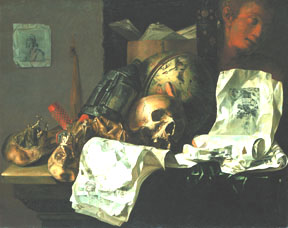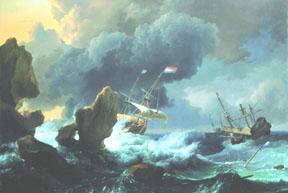By RAYMOND J. STEINER
ART TIMES
May, 2005
 "Vanitas" 1661 Oil on Canvas by N.L. Peschier |
ON THE FEW trips I’ve taken to the Netherlands during which I had the time to explore — Amsterdam, Bruges, Brussels, Leuven, Antwerp — I almost always found myself looking for those land- and townscapes, those tiny inner courtyards, those dark taverns filled with red-faced imbibers of brim-filled mugs of foamy beer, those narrow, twisty streets that almost always led down to some waterway, if not, in fact, to the sea itself — scenes that I could vividly recall from hours of looking at Netherlandish paintings. There were echoes, surely. You can still stumble onto one of those narrow streets today, but somehow not quite the same ones I remember from the paintings and drawings of Vermeer, de Hooch, Fabritus, Visscher, Vinckboons, or Lamberts, for instance.
I
knew, of course, the foolishness of my somewhat romantic notions, knew that
the art I was familiar with was centuries old and, well, today was today. Still,
one cannot deny the vivid immediacy of those old Dutch masters, a “thereness”
in their art that is so tangible that one almost must believe that they
still exist, that these homes, these windmills, these taverns and wooden ships,
still stand in the precise locations in which those painters found them. Such
striking realism, such fidelity to the object, has always been a hallmark of
the Lowland painters, a signature if you will, of the stolid, down-to-earth,
practical nature of the Dutch people. Their art, in a word, has been almost
always considered to be “timeless” — thus the trick of the
mind that expects us — at least, me — to revisit times and places
that have long since passed from this earth.
Time and timelessness, and the relationship of these abstractions to the mind, in fact, lie at the heart of the unifying theme which informs the present exhibition at The Frances Lehman Loeb Art Center* at Vassar College. The brainchild of its organizer, Susan Donahue Kuretsky, “Time and Transformation” is a presentation of Dutch art in an intricate context of culture, psychology, art history, aesthetics, sociology, and, finally, informed conjecture. Kuretsky, Professor of Art at Vassar College, locates the seminal seed for this exhibit in an art history course she took at Vassar in 1962 and, in particular, a term paper she wrote for that course on Daniel Vosmaer’s “View of a Dutch Village with a Ruined Wall” (Cat. No. 44 in the present exhibit and the cover-art for the accompanying catalogue). “Time and Transformation”, by any standard, is an outstanding tribute to the power that can be generated by a single work of art and to the accomplishments of a dedicated and determined intellectual pursuit for understanding by an outstanding scholar. The fruits of Kuretsky’s forty-year journey into the impact and implications of art on not only the individual psyche but also on the course of human development are evident both in her introductory essay, “Dutch Ruins: Time and Transformation” that opens the catalogue, and in this impressive gathering of some ninety works — paintings, prints and drawings — from the hands of 60 Dutch masters, including the work of the Bloemaerts (both Abraham and Frederick), Aelbert Cuyp, Gerard Dou, Jan Van Goyen, Willem Kalf (whose little oil on panel, “A Kitchen Corner” is a joy to contemplate), Jan Lievens, Nicolaes Maes, Isack Van Ostade, Rembrandt van Rijn, Jacob Van Ruisdael, Adriaen Van de Venne (one of my own personal favorite Netherlandish artists), and Joachim Wtewael.
 "Ships in Distress off a Rocky Coast" 1667 Oil on Canvas by Ludolf Backhuysen |
Looking
at Dutch art is almost always a pleasurable experience — don’t miss
stopping for a bit in front of Rembrandt’s wonderful etching of Saint
Jerome with the Pollard Willow, Ludolf Backhuysen’s magnificent treatment
of the sea in his oil, Ships in Distress off a Rocky Coast, Ruisdael’s
Landscape with a Dead Tree in oil, Pynacker’s large oil, Landscape
with Hunters, Breenbergh’s tiny print series, Various ruined buildings
within and without Rome, Peschier’s and Bailly’s Vanitas
and Vanitas Still Life with Portrait (respectively) and, of course, the
Willem Kalf noted previously — and, along with the variety and number
of others that this exhibit offers, the viewer will almost assuredly not be
disappointed.
As gratifying as viewing these works on their own terms
may be, however, having the opportunity of seeing them through new eyes is a
rare treat, indeed. Don’t miss therefore, seeing the work in the multi-textured
framework in which they are presented — and especially bring home the
catalogue and take the time to absorb the insights and observations offered
by Kuretsky and her fellow scholars, Walter S. Gibson, Catherine Levesque, Erik
P. Löffler, Lynn Federle Orr, and Arthur K. Wheelock, Jr.
Kudos to Susan Donahue Kuretsky and her colleagues,
to James Mundy, Director of the Art Center, and to the thirty lenders to the
exhibition for undertaking, supporting, and presenting this special contribution
to the public.
*“Time and Transformation in Seventeenth-Century Dutch Art (thru Jun 19): The Frances Lehman Loeb Art Center, Vassar College, 124 Raymond Ave., Poughkeepsie, NY (845) 437-5632 fllac.vassar.edu. After closing at Vassar, the show will travel to the John and Mable Ringling Museum of Art in Sarasota (Aug 20-Oct 30) and close at the Speed Art Museum, Louisville (Jan 10-Mar 26, 2006). (A fully-illustrated catalogue is available).